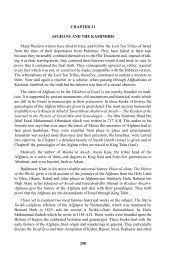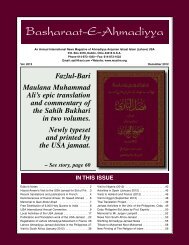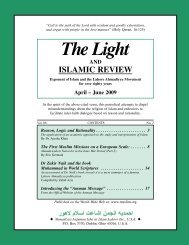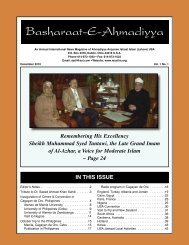From Arabia to the Himalayas - The Lahore Ahmadiyya Movement in ...
From Arabia to the Himalayas - The Lahore Ahmadiyya Movement in ...
From Arabia to the Himalayas - The Lahore Ahmadiyya Movement in ...
Create successful ePaper yourself
Turn your PDF publications into a flip-book with our unique Google optimized e-Paper software.
LAHORE AHMADIYYA MOVEMENT AND ALBANIA IN INTER-WAR PERIOD 7<br />
Egyptian newspaper a declaration <strong>in</strong> which <strong>the</strong>y acknowledged <strong>the</strong>ir mistake and <strong>the</strong> deviance<br />
of Ahmadi doctr<strong>in</strong>es. 35 As for Sherif Putra, he also went back <strong>to</strong> Albania, at <strong>the</strong> latest dur<strong>in</strong>g<br />
1939, s<strong>in</strong>ce <strong>in</strong> September he became edi<strong>to</strong>r <strong>the</strong>re of <strong>the</strong> Islamic Community’s new<br />
publication.<br />
Picture with caption: Sherif Putra became edi<strong>to</strong>r of <strong>the</strong><br />
Community’s journal on his return from <strong>Lahore</strong><br />
<strong>The</strong> search for a ‘modern’, ‘European’ Islam and its limitations<br />
Why did <strong>the</strong> leaders of Albanian Islam and <strong>the</strong> young executives whom <strong>the</strong>y had<br />
begun <strong>to</strong> educate turn <strong>to</strong>wards <strong>Lahore</strong> and <strong>the</strong> <strong>Ahmadiyya</strong> Anjuman Isha’at al-Islam? Let us<br />
go back over <strong>the</strong> Albanian situation <strong>in</strong> order <strong>to</strong> understand <strong>the</strong>se l<strong>in</strong>ks forged with an Indian<br />
Islam. When, <strong>in</strong> 1927, <strong>the</strong> Anjuman made contact with <strong>the</strong> Albanian Islamic Community, a<br />
debate over <strong>the</strong> reform of Islam and Islamic <strong>in</strong>stitutions was gett<strong>in</strong>g underway <strong>in</strong> Albania. At<br />
<strong>the</strong> centre of this discussion, which covered <strong>the</strong> pages of <strong>the</strong> Community’s publication, was<br />
Salih Vuçitern, Direc<strong>to</strong>r General of Vakfs (<strong>the</strong> Islamic Community’s properties <strong>in</strong><br />
mortma<strong>in</strong>). 36 Very close <strong>to</strong> President Ahmed Zogu, back <strong>in</strong> position aga<strong>in</strong> as Head of State<br />
s<strong>in</strong>ce <strong>the</strong> end of <strong>the</strong> year 1924, and true <strong>in</strong>termediary between <strong>the</strong> political authorities and <strong>the</strong><br />
Islamic Community, Salih Vuçitern made an appeal at that time directed <strong>to</strong>wards <strong>the</strong> “need<br />
for reform”. In it, he was suggest<strong>in</strong>g a reorganisation of <strong>the</strong> vakfs, <strong>the</strong> closure of unnecessary<br />
mosques, <strong>the</strong> suppression of <strong>the</strong> regional medrese’s and <strong>the</strong>ir replacement by two board<strong>in</strong>g<br />
schools, at Shkodra and at Tirana, where a modern religious education would be provided. He<br />
was motivated <strong>in</strong> this by <strong>the</strong> fact that <strong>the</strong> Albanian Muslims were “surrounded on all sides by<br />
cultured peoples” and that <strong>the</strong> only means of survival, under <strong>the</strong>se conditions, was <strong>to</strong> raise <strong>the</strong><br />
standards of Albanian society. 37 Of course, this move should be placed <strong>in</strong> <strong>the</strong> wider context of<br />
<strong>the</strong> politics of <strong>the</strong> reforms carried out by Ahmed Zogu, all <strong>the</strong> more so as Salih Vuçitern, an<br />
admirer, moreover, of Atatürk, was one of his close advisers. This policy led notably <strong>to</strong> <strong>the</strong><br />
<strong>in</strong>troduction of <strong>the</strong> civil code <strong>in</strong> 1928, <strong>the</strong> reorganisation of religious Communities <strong>in</strong> 1929,<br />
with <strong>the</strong> aim of state control, and <strong>the</strong> abolition of wear<strong>in</strong>g <strong>the</strong> veil <strong>in</strong> 1937.<br />
<strong>The</strong> aid that <strong>the</strong> Anjuman offered for <strong>the</strong> purpose of “<strong>the</strong> spiritual advancement of<br />
Albanian Muslims”, of sett<strong>in</strong>g <strong>the</strong>m on “<strong>the</strong> road <strong>to</strong> progress”, and of caus<strong>in</strong>g <strong>the</strong>m <strong>to</strong><br />
“surpass <strong>the</strong>ir enemies” corresponded exactly, <strong>the</strong>n, <strong>to</strong> <strong>the</strong> process that Salih Vuçitern wanted<br />
<strong>to</strong> set <strong>in</strong> motion. Is it any wonder, <strong>the</strong>n, that it was he who, <strong>in</strong> 1928, only one year, <strong>the</strong>refore,<br />
after <strong>the</strong> first contacts with <strong>the</strong> <strong>Ahmadiyya</strong> <strong>Movement</strong>, made an appeal for funds <strong>in</strong> each<br />
prefecture <strong>in</strong> order <strong>to</strong> publish a number of books and distribute <strong>the</strong>m free of charge, <strong>in</strong>clud<strong>in</strong>g<br />
Muhammed — Our Prophet by Muhammad Ali, adopt<strong>in</strong>g, <strong>the</strong>refore, an approach close <strong>to</strong> <strong>the</strong><br />
one suggested by <strong>the</strong> Assistant Secretary of <strong>the</strong> Anjuman? 38 Three years later, when <strong>the</strong> book<br />
35 Cf. AQSh, F. 882, v. 1939, d. 95, and Oriente Moderno, XX, 1940, p. 460.<br />
36 Born <strong>in</strong> 1880 at Vuçitern (<strong>in</strong> Kosovo), Salih Vuçitern had undertaken <strong>the</strong>ological and secondary school<br />
education <strong>in</strong> Istanbul. Arriv<strong>in</strong>g <strong>in</strong> Albania at <strong>the</strong> time of <strong>the</strong> Balkan wars (1912–1913), he was notably Inspec<strong>to</strong>r of<br />
Education <strong>in</strong> <strong>the</strong> Mat region <strong>in</strong> 1919 and Prefect of Dibra <strong>in</strong> 1922. In 1921, he was Direc<strong>to</strong>r General of Vakfs, a<br />
post that he occupied until 1939, <strong>the</strong>n once more from 1942 onwards. He was a Deputy from 1921 <strong>to</strong> 1925 and<br />
from 1928 <strong>to</strong> 1932, and a Sena<strong>to</strong>r from 1925 <strong>to</strong> 1928. <strong>From</strong> 1928 <strong>to</strong> 1930, he was M<strong>in</strong>ister of Public Works.<br />
Dur<strong>in</strong>g <strong>the</strong> 1930’s, he was <strong>in</strong> charge of <strong>the</strong> adm<strong>in</strong>istration of agricultural reform. In 1938, he was president of<br />
SITA, <strong>the</strong> Electricity Society of Tirana. Dur<strong>in</strong>g <strong>the</strong> Italian occupation, he was <strong>in</strong>terned for two and a half years. A<br />
Zog loyalist and member of <strong>the</strong> militant movement support<strong>in</strong>g his res<strong>to</strong>ration, he was arrested <strong>in</strong> Oc<strong>to</strong>ber 1945 by<br />
<strong>the</strong> communist authorities and died <strong>in</strong> prison four years later (cf. Taylor 1937, p. 1146; Schmidt-Neke 1987, p.<br />
355; Vllamasi 1995, see Index).<br />
37 ‘Deklaratë. Mbi nevojen e reformave’, Zani i naltë, IV/7, Fruer 1927, p. 196–207.<br />
38 <strong>The</strong> process was repeated <strong>in</strong> 1944, on <strong>the</strong> same l<strong>in</strong>es (cf. Kultura islame, V/7–8, Mars–Prillë 1944, p. 204).


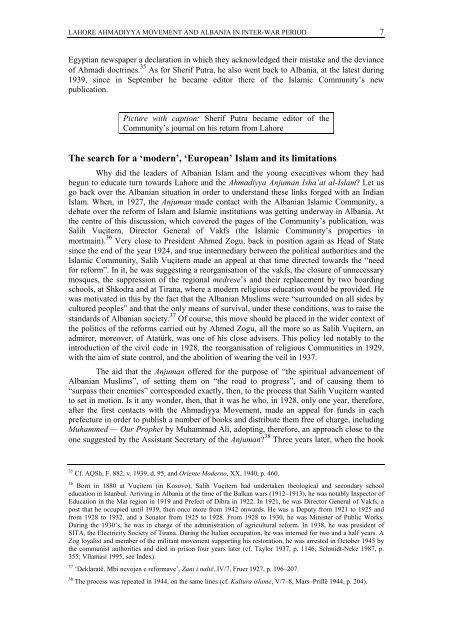
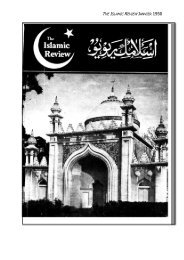
![Part 2] HARD TRIALS NECESSARY TO ESTABLISH TRUTH 69 152 ...](https://img.yumpu.com/11777151/1/167x260/part-2-hard-trials-necessary-to-establish-truth-69-152-.jpg?quality=85)

